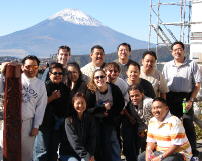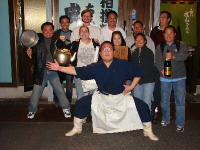After touring the Sumo Museum it was a short walk to the Edo-Tokyo Museum. Now this was a museum! Dean and his Mom had visited the museum on a prior trip to Japan and spent over four hours viewing the exhibits. When he offered it as an option for our Japan trip we all leaped at the chance to visit. The Edo-Tokyo Museum was founded on March 28,1993. The building tries to imitate a Japanese style elevated-floor warehouse. At its highest point, the building is over 62 meters. The museum grounds covers about 30,000 square meters and is more than twice the size of the field area inside the Tokyo Dome stadium. http://www.edo-tokyo-museum.or.jp/english/ 
Upon entering the exhibit area you are greeted by a replica of the old Nihonbashi Bridge. You cross this bridge to reach the permanent Edo exhibit. Nihonbashi Bridge was the doorway from Edo (current day Tokyo) to such places as Kyoto (to the west) and Nikko (to the north). The original Nohonbashi Bridge had a length of 51 meters and a width of 8 meters. The replica at the Edo-Tokyo Museum is of the same width as the original but of half the length.
Crossing the bridge was an awesome way to start our tour of the museum. What made the bridge even more significant was the fact that we had just walked over the modern day Nihonbashi Bridge the day before after touring the Imperial Palace outer grounds. (See picture below)

Most of the pictures I took at the museum came out very dark. This was because we were not allowed to take flash pictures inside the museum. We weren't quite sure if this was a restriction for the entire museum but to play it safe we all left our flashes off. So to supplement my personal pictures in this posting I have included pictures from the official Edo-Tokyo Museum website.
 One of the neat things about the museum was the miniature models of different areas of significance in old Edo. The picture above is of a 1/30 scale representation of the the west side of the Ryogoku bridge. In old Edo it featured a large open area, originally designed as a firebreak. This soon became one of the most popular spots in the city, where numerous spectacle houses and street performances could be viewed. These models were extremely detailed down to the miniature people who were all appropriately garbed as well.
One of the neat things about the museum was the miniature models of different areas of significance in old Edo. The picture above is of a 1/30 scale representation of the the west side of the Ryogoku bridge. In old Edo it featured a large open area, originally designed as a firebreak. This soon became one of the most popular spots in the city, where numerous spectacle houses and street performances could be viewed. These models were extremely detailed down to the miniature people who were all appropriately garbed as well. 
Although most of the exhibits in the museum were built to a reduced scale size, a few were actually built on a 1 to 1 scale of the actual building or monument including this one of the Nakamuraza Playhouse.
The above picture is of the entryway into the Nakamuraza Playhouse where Kabuki Theater was often performed. Above the roof is a banner proclaiming the permission to operate as given by the bakufu. (The government) Beautiful signboards above the door give the names of the plays showing as well as the names of the actors who were to appear.
 Now I know that this posting was supposed to be about the Edo-"TOKYO" Museum and you've probably noticed that I haven't shown any pictures or mentioned anything about the Tokyo part of it. While I thought the Tokyo displays were great as well, I am a really big fan of old Japan, and the Edo displays really captured my interest and imagination. I'll leave the Tokyo part for another time and finish with this picture of Rei and Mrs. Sakata standing on a map of the Edo/Tokyo area.
Now I know that this posting was supposed to be about the Edo-"TOKYO" Museum and you've probably noticed that I haven't shown any pictures or mentioned anything about the Tokyo part of it. While I thought the Tokyo displays were great as well, I am a really big fan of old Japan, and the Edo displays really captured my interest and imagination. I'll leave the Tokyo part for another time and finish with this picture of Rei and Mrs. Sakata standing on a map of the Edo/Tokyo area.



 One of the neat things about the museum was the miniature models of different areas of significance in old Edo. The picture above is of a 1/30 scale representation of the the west side of the Ryogoku bridge. In old Edo it featured a large open area, originally designed as a firebreak. This soon became one of the most popular spots in the city, where numerous spectacle houses and street performances could be viewed. These models were extremely detailed down to the miniature people who were all appropriately garbed as well.
One of the neat things about the museum was the miniature models of different areas of significance in old Edo. The picture above is of a 1/30 scale representation of the the west side of the Ryogoku bridge. In old Edo it featured a large open area, originally designed as a firebreak. This soon became one of the most popular spots in the city, where numerous spectacle houses and street performances could be viewed. These models were extremely detailed down to the miniature people who were all appropriately garbed as well. 



No comments:
Post a Comment